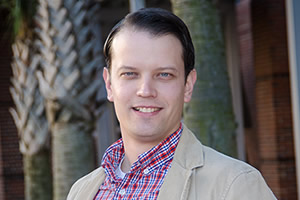Congratulations to Dr. Gregory Hudalla, associate professor, for his article, “Charge guides pathway selection in β-sheet fibrillizing peptide co-assembly” which has published in the prestigious Nature journal Communications Chemistry.
Communications Chemistry Paper
The assembly of peptides into elongated fibrillar structures is widely used to create biomaterials for medical and biotechnology applications. Co-assembly is a unique scenario in which two distinct peptides (e.g., A and B) associate to form a single supramolecular structure. Combining two different peptides into a single fibrillar architecture often leads to biomaterials with a new form and function that is not accessible in single-component systems; however, emergence of these properties depends on the peptide content of the final assembled structure, which is difficult to predict in multicomponent systems due to the multitude of molecular interactions that are possible. Our research team is pursuing an understanding of the molecular determinants that govern peptide co-assembly toward the goal of designing new biomaterials with precisely defined structures and compositions.
Building off of work reporting a pair of charge-complementary co-assembling peptides referred to as CATCH (Co-Assembly Tags based on CHarge) for non-covalent immobilization of fusion proteins [1], Drs. Hudalla and Seroski teamed up with the groups of Dr. Carol Hall, an expert in computational modeling, and Dr. Anant Paravastu, an expert in solid-state NMR, to understand peptide co-assembly in greater detail. Previously, our team has shown that the “CATCH+” and “CATCH-“ peptide pair of form nanofibers in which the two molecules are predominantly arranged in an alternating +-+-+- sequence; however, a significant, unanticipated deviation from this pattern (i.e., ++ and — neighbors) is also observed [2]. Further, we’ve shown that molecules within co-assembled peptide nanofibers do not adopt a single configuration. Rather, the molecular-level structure is highly promiscuous [3]. Collectively, these observations underscore the need for systematic studies to understand how molecular features influence nanofiber formation, composition, structure, and function.
In our new paper published in Communications Chemistry [4], our collaborative team sought to understand how the number of charged residues influences CATCH peptide co-assembly. Toward that end, we created variants of CATCH+ and CATCH- with two, four, or six charged residues (Fig. 1a). This design was based in part on prior reports suggesting that peptides with two charged residues are likely to undergo self-assembly into fibrillar structures, while those with a greater number of charged residues are likely to remain un-assembled (Fig. 1b); however, this was largely speculative because systematic studies examining relationships between peptide charge and the propensity for self- versus co-assembly pathways are lacking.
Our report demonstrates that mixtures of CATCH(2+/2-), CATCH(4+/4-), and CATCH(6+/6-) co-assemble into nanofibers rich in beta-sheets; however, CATCH(2+) can self-associate to form nanofibers, whereas all other peptides required a complementary-charged partner to assemble. Solid-state NMR suggested that the CATCH+ peptide predominated in the final assemblies, with the ratio of positive to negative peptides approaching two as charge increased. Unexpectedly, biophysical experiments and computational modeling each demonstrated that the rate of peptide co-assembly increases with peptide charge, despite considerable differences in time scale and number of molecules within each system, highlighting the significance of our collaborative approach to refine our understanding of peptide fibrillization.
Toward our long-term goal of identifying molecular determinants that guide peptide co-assembly, this report demonstrates that increasing charge draws complementary peptides together faster, favoring co-assembly, while like-charged molecules repel. However, the imbalance of positive and negative peptides in the resulting nanofibers suggests that charge plays a more significant role at long rather than short intermolecular distances. Thus, charge alone is likely insufficient for encoding the assembly of perfectly alternating two-component nanofibers; rather, future efforts should seek to balance long-range charge effects with short-range intermolecular complementarity to arrive at compositional precision.

Figure 1: Schematic of CATCH peptide and their assembly. (A) Schematic of residue placement in CATCH peptides. (B) Schematic of hypothesized reaction rates based on number of charged residues.
References:
1. Seroski, D. T., Restuccia, A, Sorrentino, A.D., Knox, K.R., Hagen, S.J., & Hudalla, G.A. Co-Assembly Tags Based on Charge Complementarity (CATCH) for Installing Functional Protein Ligands into Supramolecular Biomaterials. Cell. Mol. Bioeng. 9, 335-350 (2016).
2. Shao, Q., Wong, K.M., Seroski, D.T., Wang, Y., Liu, R., Paravastu, A.K., Hudalla, G.A., & Hall, C.K. Anatomy of a selectively coassembled β-sheet peptide nanofiber. Proc. Natl. Acad. Sci. 117, 9, 4710-4717 (2020).
3. Wong. K.M., Wang, Y., Seroski, D.T., Larkin, G.E., Mehta, A.K., Hudalla, G.A., Hall, C.K., & Paravastu, A.K. Molecular complementarity and structural heterogeneity within co-assembled peptide β-sheet nanofibers. Nanoscale. 12, 4506 (2020).
4. Seroski, D.T., Dong, X., Wong, K.M., Liu, R., Shao, Q., Paravastu, A.K., Hall, C.K., & Hudalla, G.A. Charge guides pathway selection in β-sheet fibrillizing peptide co-assembly. Communications Chemistry, 3:172 (2020) https://rdcu.be/caKks

